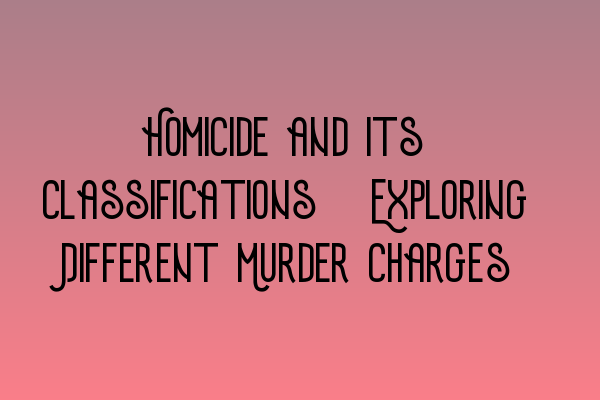Homicide and its Classifications: Exploring Different Murder Charges
In the criminal justice system, homicide is the act of one person causing the death of another. It is a serious offense that carries severe penalties. This blog post will delve into the various classifications of homicide and provide an overview of different murder charges.
1. First-Degree Murder
First-degree murder is the most serious homicide charge. It involves the intentional and premeditated killing of another person. This means that the defendant planned and thought about the act beforehand. First-degree murder is often referred to as “planned” or “premeditated” murder. To be convicted of first-degree murder, the prosecution must prove both the intent to kill and the premeditation beyond a reasonable doubt. For more detailed information on this subject, you can refer to our SQE 1 Practice Exam Questions article.
2. Second-Degree Murder
Second-degree murder is a lesser charge compared to first-degree murder. It is characterized by the intentional killing of another person without premeditation. Unlike first-degree murder, the act is not pre-planned. It is often referred to as a “spontaneous” or “impulsive” act. To be convicted of second-degree murder, the prosecution needs to prove that the defendant had the intention to cause serious harm or knew that their actions could result in death. More information on second-degree murder can be found in our SQE 1 Practice Mocks FLK1 FLK2 article.
3. Manslaughter
Manslaughter is another type of homicide charge. It is defined as the unlawful killing of another person without malice aforethought. Unlike murder charges, manslaughter typically involves negligence, recklessness, or a lack of intent to cause death. There are two main types of manslaughter: voluntary and involuntary. Voluntary manslaughter occurs when there is an intentional killing in the heat of passion or due to adequate provocation. Involuntary manslaughter, on the other hand, is unintentional but caused by the defendant’s reckless or negligent behavior. To learn more about manslaughter and its nuances, check out our dedicated SQE 2 Preparation Courses article.
4. Other Homicide Charges
Aside from murder and manslaughter, there are other specific homicide charges that are worth mentioning:
- Felony Murder: This charge applies when a death occurs during the commission of a felony, even if the killing was unintentional. It holds all participants in the felony responsible for the death.
- Infanticide: Infanticide refers to the unlawful killing of a child who is less than 12 months old, and the mother has not fully recovered from giving birth.
- Attempted Murder: Attempted murder is charged when there is intent to kill, but the victim survives due to intervention or other factors.
If you are studying for the SQE exams or seeking more information about criminal law, we highly recommend exploring our comprehensive SQE 1 Preparation Courses. These resources are designed to help you understand the intricacies of criminal law and prepare for the SRA SQE Exam Dates.
In conclusion, understanding the various classifications of homicide is crucial for anyone involved in the legal field. Whether you are studying for exams or just looking to expand your knowledge, knowing the differences between first-degree murder, second-degree murder, manslaughter, and other related charges is vital. Remember to tread cautiously and always consult with legal experts for specific cases or advice.
